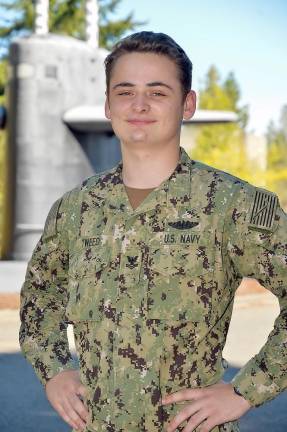Sparta native serves as a member of U.S. Navy’s ‘Silent Service’
Sparta. Petty Officer 2nd Class Ethan Tweed: “We are a nuclear deterrence, and our existence keeps the world safe.”

A Sparta native is serving aboard USS Pennsylvania, one of the world’s most advanced nuclear-powered submarines.
Petty Officer 2nd Class Ethan Tweed serves as a machinist’s mate and joined the Navy to use the skills he gained in the civilian world to serve a higher purpose.
“I love the water, because I grew up working on boats and worked at a marina before joining the Navy,” said Tweed.
Tweed attended Sparta High School and graduated in 2017. Today, Tweed uses skills and values similar to those found in Sparta.
“I worked on and around boats my entire life,” he said.
These lessons have helped Tweed while serving aboard USS Pennsylvania.
Known as America’s “Silent Service,” the Navy’s submarine force operates a large fleet of technically advanced vessels. These submarines are capable of conducting rapid defensive and offensive operations around the world, in furtherance of U.S. national security.
There are three basic types of submarines: fast-attack submarines (SSN), ballistic-missile submarines (SSBN) and guided-missile submarines (SSGN).
Fast-attack submarines are designed to hunt down and destroy enemy submarines and surface ships; strike targets ashore with cruise missiles; carry and deliver Navy SEALs; conduct intelligence, surveillance, and reconnaissance missions; and engage in mine warfare.
The Navy’s ballistic-missile submarines, often referred to as “boomers,” serve as a strategic deterrent by providing an undetectable platform for submarine-launched ballistic missiles. SSBNs are designed specifically for stealth, extended patrols and the precise delivery of missiles.
Guided-missile submarines provide the Navy with unprecedented strike and special operation mission capabilities from a stealthy, clandestine platform. Each SSGN is capable of carrying 154 Tomahawk cruise missiles, plus a complement of heavyweight torpedoes to be fired through four torpedo tubes. As a member of the submarine force, Tweed is part of a rich 121-year history of the U.S. Navy’s most versatile weapons platform, capable of taking the fight to the enemy in the defense of America and its allies.
Rebuilding military readiness
Serving in the Navy means Tweed is part of a team that is taking on new importance in America’s focus on rebuilding military readiness, strengthening alliances and reforming business practices in support of the National Defense Strategy.
“We are a nuclear deterrence, and our existence keeps the world safe,” said Tweed.
With more than 90 percent of all trade traveling by sea, and 95 percent of the world’s international phone and internet traffic carried through underwater fiber optic, Navy officials continue to emphasize that the prosperity and security of the United States is directly linked to a strong and ready Navy.
Strategic deterrence is the nation’s ultimate insurance program, and for decades Naval Submarine Base Bangor has been home to Ohio Class ballistic-missile submarines. Beginning in 2028, the new Columbia Class ballistic-missile submarines will arrive and provide continuous sea-based strategic deterrence into the 2080s.
Tweed and other sailors have many opportunities to achieve accomplishments during their military service.
“I’m most proud of graduating from the nuclear pipeline,” said Tweed. “It was both a physically and mentally exhausting period of time.”
As Tweed and other sailors continue to train and perform the missions to support national defense, they take pride in serving their country in the United States Navy.
“Serving in the Navy means having a job that is more than just any normal civilian job,” added Tweed.
“I’m most proud of graduating from the nuclear pipeline. It was both a physically and mentally exhausting period of time.” Ethan Tweed